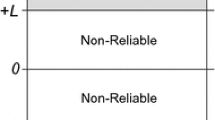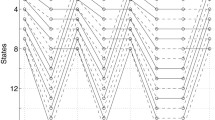Abstract
A new sequential decoding algorithm with an adjustable threshold and a new method of moving through the decoding tree is proposed. Instead of the path metric of the conventional sequential decoding algorithms, the proposed algorithm uses a branch metric based on maximum-likelihood criterion. Two new parameters, the jumping-back distance and going-back distance, are also introduced. The performance of the algorithm for long constraint length convolutional codes is compared to those of the other sequential decoding algorithms and the Viterbi algorithm. The results show that the proposed algorithm is a good candidate for decoding of convolutional codes due to its fast decoding capability and good bit error rate (BER) performance.
Similar content being viewed by others
References
Viterbi A.J. (1967) Error bounds for convolutional codes and an asymptotically optimum decoding algorithm. IEEE Transactions on Information Theory IT-13: 260–269
Wozencraft, J. M., & Reiffen, B. (1961). Sequential decoding. Massachusetts Institute of Technology Press, pp. 25–46.
Fano R.M. (1963) A heuristic discussion of probabilistic decoding. IEEE Transactions on Information Theory IT-9: 64–74
Zigangirov K.Sh. (1966) Some sequential decoding procedures. Problemy Peredachi Informatsii 2(4): 13–25
Jelinek F. (1969) Fast sequential decoding algorithm using a stack. IBM Journal of Research and Development 13: 675–678
Chevillat P.R., Costello D.J. Jr. (1977) A multiple stack algorithm for erasurefree decoding of convolutional codes. IEEE Transactions on Communications C-25: 1460–1470
Weiβ C., Riedel S., Hagenauer J. (1996) Sequential decoding using a priori information. Electronics Letters 32: 1190–1191
Li K.P., Kallel S. (1999) A bidirectional multiple stack algorithm. IEEE Transactions on Communications C-47: 6–9
Haccoun D., Ferguson M.J. (1975) Generalized stack algorithms for decoding convolutional codes. IEEE Transactions on Information Theory IT-21: 638–651
Johanesson R., Zigangirov K.Sh. (1999) Fundamentals of Convolutional Coding. IEEE Press, Piscataway, New Jersey
Han Y.S., Chen P.N., Wu H.B. (2002) A maximum-likelihood soft decision sequential decoding algorithm for binary convolutional codes. IEEE Transactions on Communications C-50: 173–178
Jacobs I.M., Berlekamp E.R. (1967) A lower bound to the distribution of computation for sequential decoding. IEEE Transactions on Information Theory IT-13: 167–174
Skalar B. (2001) Digital communications. Prentice Hall, New Jersey
Çavdar, T. (2003). A new sequential block data estimation algorithm and its performance analysis over frequency selective channels. Ph.D. dissertation, Department of Electronics Engineering, Karadeniz Technical University, Turkey.
Lin S., Costello D.J. Jr. (1983) Error control coding: Fundamentals and applications. Prentice Hall Inc., Englewood Cliffs New Jersey
Author information
Authors and Affiliations
Corresponding author
Additional information
This work was supported in part by the Research Foundation at Karadeniz Technical University under Grant 2004.112.004.01 and 2005.112.009.2.
Rights and permissions
About this article
Cite this article
Çavdar, T., Gangal, A. A new sequential decoding algorithm based on branch metric. Wireless Pers Commun 43, 1093–1100 (2007). https://doi.org/10.1007/s11277-007-9285-0
Received:
Accepted:
Published:
Issue Date:
DOI: https://doi.org/10.1007/s11277-007-9285-0




